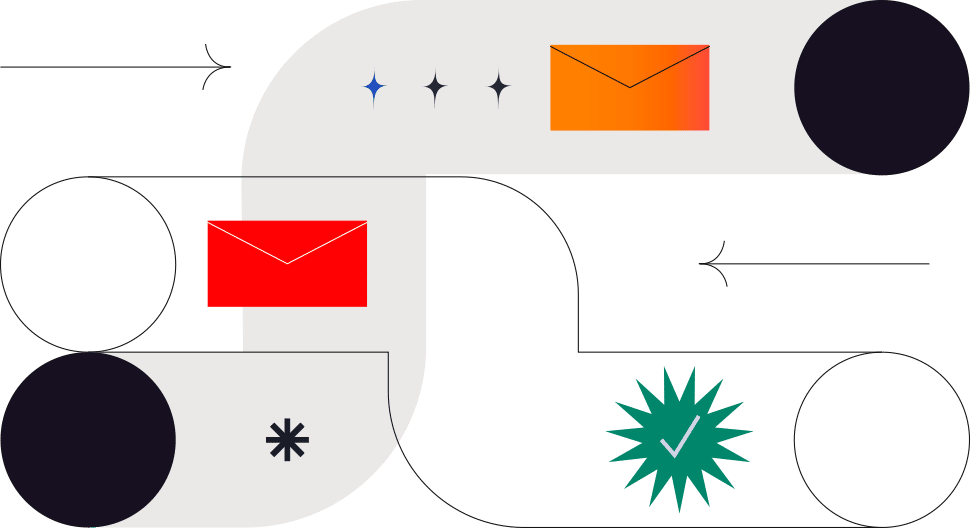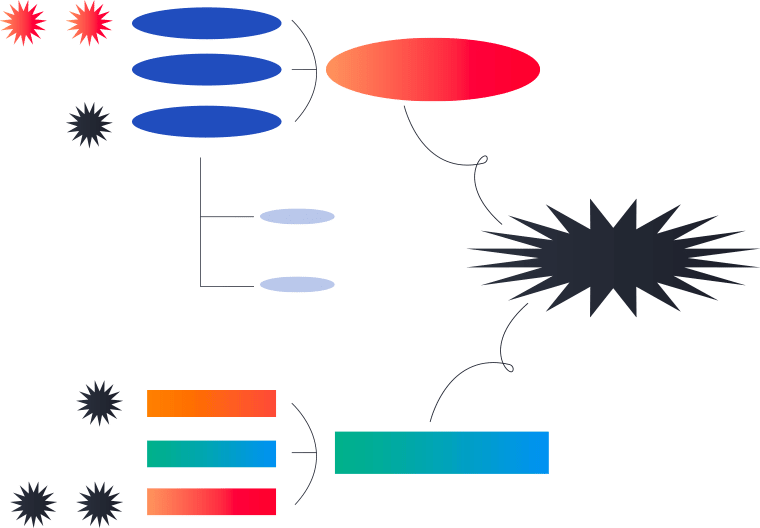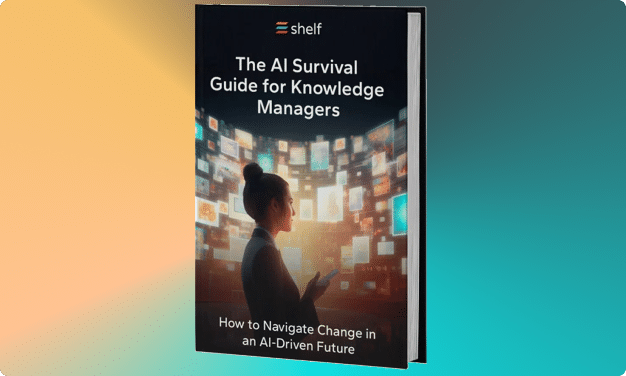Below is the story of how a global hardware and software manufacturer navigated the enterprise knowledge management landscape. Told through the lens of Julia Berg, a knowledge management leader, explore how one enterprise went from documentation chaos to finding the knowledge solution they needed for the future.
Knowledge management is one of those topics enterprises are slowly digging into, questioning, trying to understand. As a knowledge manager for a small company I experienced this reality first hand after receiving a call from a prominent global hardware and software manufacturer.
The kind of company that receives thousands of requests from customers.
Brands (even large brands) I’ve found don’t always have a gameplan for knowledge management (as was the case here), so I was excited to get to work.
Even for large companies, knowledge management simply doesn’t receive the attention the way customer service does. Companies don’t realize that many of their customer service issues stem from knowledge management issues. Forming a ‘knowledge management team’ or process is often reactive—issues start to pop up that point to knowledge as the culprit.
Today I want to share a bit of what goes on behind the scenes, describe this knowledge management evaluation process that eventually led me to recommend Shelf, and share advice for anyone starting a knowledge management project.

Knowledge audits and discovering roadblocks
I always begin with an in-depth audit of the current knowledge management processes (or lack thereof). Even in the enterprise, you need a baseline for what people do, what their roles are…and you’ll eventually uncover gaps.
We began with a simple documentation audit.
Step 1
Gather knowledge and documentation
For this technology client, I started the audit process by asking what documentation was available in the customer support department: nothing. A collection of documents and software—yes, documented processes—no.
I’m shocked at how departments can survive without any kind of documented knowledge-related process.
Companies at this scale that are surviving without documentation know they need to change in order to thrive—and that’s why I was there.
Step 2
Identify subject matter experts
The next step in my knowledge audit was to identify the subject matter expert that could vet and review documents that turn up as part of the audit. That was their operations manager (who had been at the company the longest).
Much of the knowledge he had was in his head, so we spent time compiling every article or knowledge resource we could find.
We also worked to pull together as many company subject matter experts as possible—a critical step to any enterprise knowledge audit. Knowledge management is a human-centered process that should involve as many people as it takes to understand where knowledge lives, what’s being used, and what content is actually helpful.
Step 3
Systems audit
Another key piece of this audit was uncovering any knowledge management systems and software in use. In this case, Confluence was being used, but that wasn’t the only source of knowledge I found.
The ROI of a central knowledge management solution is something leaders are just starting to pay attention to—usually after exhausting all the other customer support solutions they think can solve knowledge problems.
Often, the core problem preventing an optimal customer experience is the lack of a simple knowledge management process. As a result, knowledge repositories tend to emerge over time as was the case with this enterprise client.
“If you don’t have complete buy-in from customer support that knowledge management is a priority, chances are your customers don’t always have a great experience with the answers they receive.”
This particular client had an offshore support team; they were in the early stages of taking their global support operations seriously.
At the enterprise level, customer support operations can get complex, and this client was no different. Both their account management and technical support team required a lot of knowledge, a lot of contextualized answers that varied by region.
Unfortunately knowledge is often created absent of any defined process, which is exactly what I uncovered.
After working with the account management CS team and surveying the entire support department, below are a few problems and challenges I noticed.
Account Management
- No centralized repository of knowledge that offshore agents could refer back to
- Culture and language barriers made it challenging to account for tone, messaging, and answers
- Undocumented tribal knowledge
- Inability to achieve first contact resolution goals
- CSAT improvement opportunities
Technical Support
- Complex instructions based on dozens of troubleshooting scenarios
- No centralized source to organize technical documents
The impact of a lack of knowledge process
I soon discovered the average handle time was not where they wanted..it was taking agents a lot of time to get the right answer to the customer.
When you work with large companies, customer questions (that need an answer) often range from typical “why don’t I have this package?” to ‘how do I reset this device? I’ve tried 10 times!!’
In both cases, good answers matter.

“I noticed a pattern after a while when asking about the impact knowledge was having on the organization. Agents sometimes provided an answer in an acceptable amount of time, just not the right answer.”
As I navigated through the knowledge audit and spoke with operations managers and other stakeholders I uncovered three core challenges (all directly related):
- Quality assurance: The QA team depended on right answers; without a quality knowledge source answer quality issues were not getting resolved.
- Training: developing training was challenging because knowledge was nowhere to be found. For onboarding, it took too long to get new agents onboarded and proficient enough to handle customer inquiries.
- Change management: no process to relay important promos or policy changes to front-line agents
- Knowledge management: The root cause—no process or ownership for knowledge made it easy for bad information to negatively impact business outcomes for multiple departments.
Because no one was vetting or holding anyone accountable for answers provided to customers, no one realized the root cause of these problems was a lack of knowledge management.
Companies often invest a lot of money in personnel to support the customer experience—like QA, Learning and Development, or Operations managers. Leaders purchase software in hopes it will boost team productivity, yet don’t consider the impact and role knowledge management plays in achieving these objectives.

The importance of change management
Another knowledge-related problem I discovered was a general lack of change management. In a technology company where policies change all the time, you need a defined way to relay important updates to those who need it most.
I found out agents on the account management support team didn’t know how to respond to questions relating to seasonal promotions which was leaving them vulnerable to poor CSAT scores.
“If you don’t have complete buy-in from customer support that knowledge management is a priority, chances are your customers don’t always have a great experience with the answers they receive.”
Once I uncovered the problems and had buy-in from my manager and the Director of Customer Support, the next phase was to present my findings to a room full of engineers. Anytime I’ve approached a large group of people in a room with a new knowledge transformation concept it can be intimidating.
This particular enterprise client needed some convincing to purchase external software, because the classic build-vs-buy debate is still alive and well, particularly with engineers. We ultimately decided to search for a knowledge management platform as the best option to see immediate impact on core CS metrics.
One thing I’ve learned: KM is all about behavior change. You want to instill hygiene, the rituals that promote the knowledge culture you’re trying to achieve.
Knowledge management best practices are easier to sell when you have a blank slate, no real knowledge process—but sometimes you have to work with the existing culture for these changes to stick and actually get adopted.
Support agents are often the last to know important details even though they must relay these details to customers. When departments don’t have a process to let customer support know when things change…customers suffer.
Knowledge Management: People, Process, Technology
After the audit, I worked with operations to outline a process to address what to do when change happens—and how to communicate these changes to customer support.
Many leaders jump to technology as the solution, but knowledge management involves people to create processes and maintain the KM technology. Organizational buy-in is a separate challenge for companies with knowledge problems–something I soon found out.
I worked with a senior support manager who was extremely supportive of the knowledge management initiative. You need a leader who supports you as a knowledge manager; convincing a room full of people is one of the biggest challenges in KM—you need a champion.
“Large amounts of money are spent on software and personnel, yet people rarely think: “oh, knowledge management!”. People think: “we need good leaders, we need to build a culture, we need good training and QA”. All admirable, but knowledge delivery is what matters. At the end of the day, did the customer get the answer they needed? If yes, success. If no, failure.
Investing in knowledge creates a foundation that makes leadership, training, QA, and everyone else MORE productive!”
Gathering technology requirements
Fast forward to the vendor selection process—I started with a list of knowledge management vendors that I thought could meet the criteria the company was looking for.
I met with a lot of stakeholders just to ensure we search for software that includes the right features. The KM features needed at a large company are much different than features needed at a smaller tech company—I found this out when building requirements.

Here is a preview of the scorecard we put together, including feature requirements we ultimately found in Shelf.
Feature Request
- Integration with external and internal applications
- Ability for agents to comment and favorite
- External help center
- Automation via chatbot and answer bots
- Search
- Analytics
- Announcements
- Contextually mapped suggestions
- Decision trees
Impact
- Agents wouldn’t need to switch applications for knowledge
- Maximum agent usability
- Customers can self-serve
- Knowledge served to customers without human interaction
- Smooth, smart, and intuitive search experience
- Ability to view content gaps and optimization opportunities
- Agents alerted and aware of important changes
- Additional answer recommendations based on user input
- Complex processes simplified
Knowledge Management for the Enterprise | 2022-2023 Report
Experts have done the work! Review their framework for scoring enterprise knowledge management vendors in this year’s KM report by DMG Consulting, LLC.
“Decision trees were a big thing we wanted in a KM solution. We needed to break down hundreds of complicated and complex processes. Scrolling through pages of a long document for instructions is a real pain.”
This technology client needed processes to be simplified and easy to consume…a bit difficult to do with some vendors. The demo process was instrumental, because it gave stakeholders a chance to envision themselves using the product (not just agents) and see firsthand how complex processes were handled.

Building the business case
We ultimately decided to recommend Shelf because they were the only vendor that gave us what we needed to achieve the biggest impact in the shortest amount of time.
As a best practice, I like to show executives math to build any kind of business case, because that’s their language. Shelf really helped with that—they gave us a model for the ROI of implementing Shelf minus the cost of it. That was really helpful, especially for engineers, and higher-ups.
You need a vendor that can paint the picture of short term and long term impact.
Implementation and creating knowledge infrastructure
The impact of Shelf was immediate on the account management side of the house, agents now had better defined processes and a system they could rely on immediately for answers.After implementation, phase 2 involved migrating content for their
Technical Support team into the platform. It’s tricky to migrate complex documentation without a knowledge management system like Shelf, because it’s very server-like; you can migrate what you need without attaching links or forcing knowledge in a card or wiki format.

A word of advice on knowledge implementations
In the enterprise, flexibility is key. As you can imagine, technical support documentation is dense, complex, and needs a solution that treats knowledge as infrastructure to be used anywhere.
When I am asked by a company to implement practices that support knowledge, there are different approaches I take depending on the knowledge culture.
One core concept I try to instill in each client is the idea of continuous improvement. Agents in the company I worked with couldn’t show improvement in key metrics because company knowledge was either incorrect or nowhere to be found.
You need great knowledge to see continual improvement in an area like customer service, and a built-in feedback loop. Practically speaking, your knowledge technology should provide this infrastructure—as we found in Shelf—to deliver a trusted base of knowledge others rely on.
“The demo process was really the key part. Once we built a list of requirements we knew we needed something robust enough to handle complex documentation. We saw Shelf in action and thought—THAT’s what we need.”
At the end of the day, enterprises need knowledge infrastructure to serve customers, and the right solution for the job.

About Julia Berg
A KCS certified leader and Sr. Manager of Knowledge Management, Julia is passionate about helping others reach their full potential. Her expertise in knowledge and change management has helped organizations develop effective processes, systems, and strategies for learning and change.





